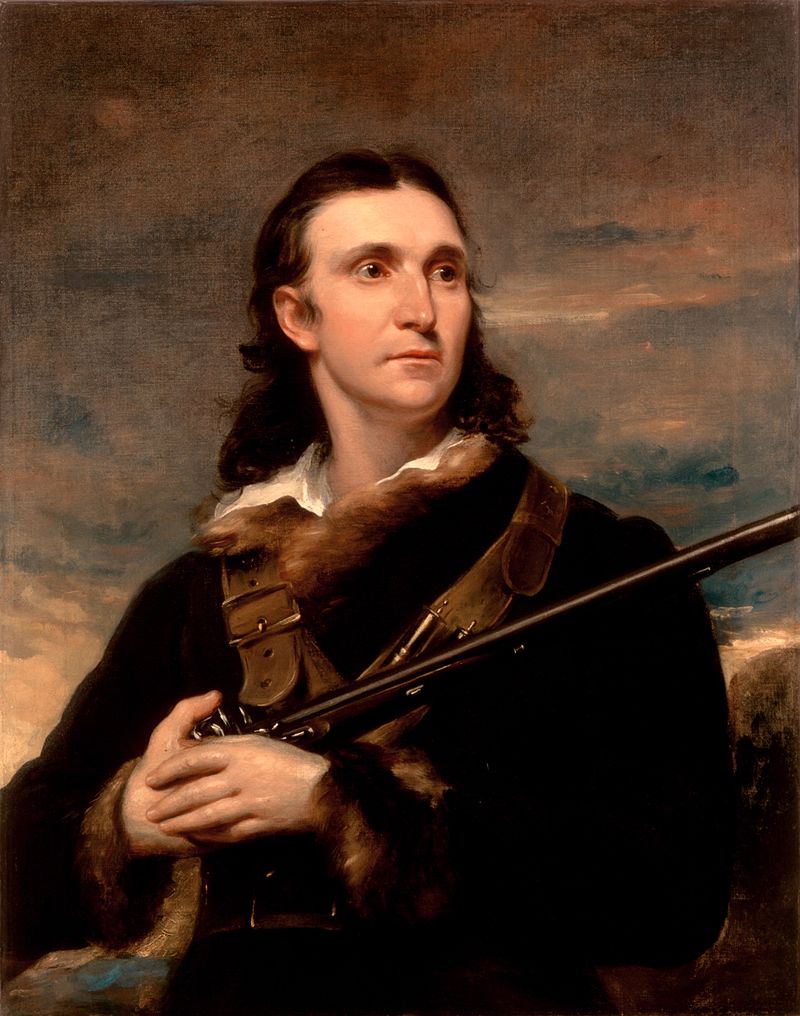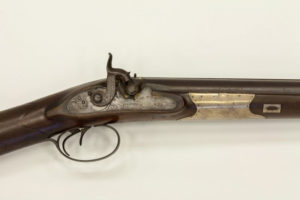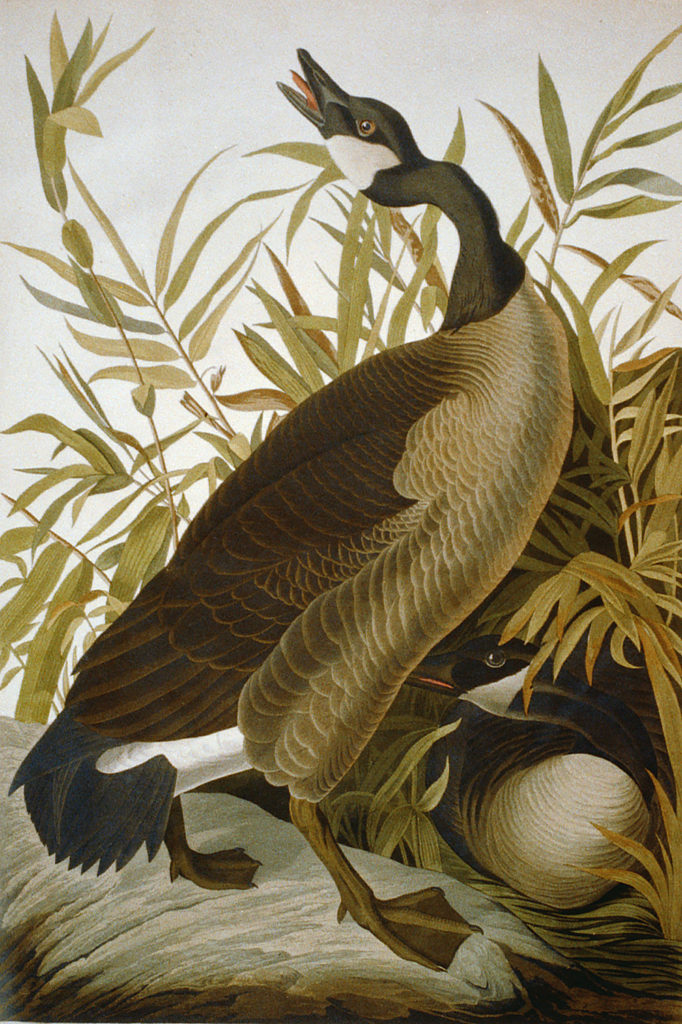
Portrait of John James Audubon by John Syme, painted in 1826 when Audubon was touring the United Kingdom to raise money and find a printer for his Birds of North America.
ON THE AFTERNOON OF DECEMBER 21, 1826, forty-one-year-old John Audubon looked out on the streets of Edinburgh, Scotland, from his second-story room after a day spent with two naturalists who wanted to learn his techniques for painting birds. He’d been in Edinburgh for nearly two months, away from home for nearly eight, and in spite of the acclaim he had met in the British Isles, he was worn out with luncheons, eight-course dinners, and the attentions of the aristocracy.
“The weather is clear, with a sharp frost,” he confided to his journal. “What a number of Wild Ducks I could shoot on a morning like this, with a little powder and plenty of shot.”[i]
His visit to Britain was a desperate attempt to find support for the project that had been the central dream of his life— an oversized book of his paintings of the birds of North America. America had not supported the idea, partly because engravers there said the plates were too challenging, partly because he had enemies, some of his own making, some who owed loyalty to his predecessor in the work of identifying American birds, the pioneer naturalist Alexander Wilson.
So necessity had brought him to the Old World to find printers skillful enough to reproduce his work and patrons wealthy enough to support it.
He called himself the American Woodsman, and while he was no Daniel Boone, there’s no doubt that, by this time in his life, he had earned his moccasins with years of wandering in the near-wilderness of the Ohio and Mississippi valleys. He came to his backwoods experiences by a circuitous route. The illegitimate son of a French naval officer and a slave girl in Santo Domingo, he grew up in the French countryside. It was that experience that kindled the two great passions of his life: birds and art.
During the American Revolution, his father spent some time in the United States and bought a farm near Philadelphia. In 1803, he sent the young Audubon there, partly to help manage the place and partly to put him beyond the insatiable demand of Napoleon’s military draft. Audubon left the farming to the Quaker tenant, preferring to spend his time in the woods. “Hunting, fishing, drawing, and music occupied my every moment,”[ii] he remembered years later.
Utterly uninterested in the farm, he set out down the Ohio River in 1807 with his new wife and a friend from France. The stated goal of the trip was to establish a store on the Kentucky frontier, but it soon became clear that Audubon was far more interested in the wilderness than in commerce.
In 1807, settlement of the Ohio River valley was just beginning. While big game and passenger pigeons got top billing in most journals of the time, the flocks of waterfowl were undoubtedly spectacular. Audubon took them mostly for granted, but in his recollections of those early years, a whisper of the old abundance emerges.
“I never spent a winter without observing immense flocks of these birds,” he wrote of the Canada geese along the river, “especially in the neighborhood of Henderson, where I have killed many hundreds of them, as well as on the Falls of the Ohio at Louisville, and in the neighboring country.”
Nor were Canadas the only species of goose he found along the Ohio. He recalled an “English gentlemen, who spent a few weeks with me at Henderson, [and] was desirous of having a tasting of some of our game. His desire was fully gratified, and the first that was placed before him was a White-fronted Goose. I had killed seven of these birds, the evening before, in a pond across the Ohio, which was regularly supplied with flocks from the beginning of October to the end of March. He pronounced it ‘delicious’. . . .”
In the winter of 1810, he and his business partner loaded several barrels of Kentucky whiskey on a keelboat and headed to the settlements in eastern Missouri to try the markets there.
“We could easily perceive that the severe and sudden frost which had just set in had closed all the small lakes and lagoons in the neighborhood,” he remembered eighteen years later, “as thousands of wild waterfowl were flying and settling themselves on the borders of the Ohio.” As they passed Cache Creek, just above the confluence of the Ohio River and the Mississippi, he saw “innumerable ducks driven by winter to the south from the Polar Regions” along with “thousands of paroquets [Carolina parakeets] that came to roost.”
His party stopped at Cache Creek in Illinois Territory where they shared a campsite with a band of Shawnee. The natives had found a lake on the Tennessee side of the river “to which immense flocks of swans resorted every morning.” The swan skins were valuable in trade, so the Shawnee and white men made plans to set an ambush the next morning.
The next day— Christmas Day, 1810, as it turned out— Shawnee women paddled the hunters across the river and spent the morning hunting for nuts while the men made their way through the willow thickets and surrounded the backwater. “There they lie,” Audubon wrote, “by hundreds, of a white or rich cream color— either dipping their black bills in the water, or leaning backwards and gently resting with one leg, expanded. Men were placed behind the trees who knew how to take a dead aim, and every shot told.”
There’s no record of what firearms Audubon carried on this trip, although his shotgun was certainly a flintlock and probably one of the best that could be had with the last of his father’s funds. He was, by all accounts, an excellent wing shot, and his report of this morning suggests that many of the swans were taken on the wing. However, the party was shooting for the market, not for pleasure, and as the birds flew back and forth from one group of men to the other, no mercy was shown.
“What would those English sportsmen . . . say to this day’s devastation amongst the swans? I saw these beautiful birds floating on the water, their backs downwards, struggling in the last agonies of life to the number of at least fifty, their beautiful skins all intended for the ladies of Europe.”[iii]
Such was frontier waterfowling in 1810.
His shop-keeping business and subsequent investments eventually failed, in no small part because Audubon couldn’t bear to tend the store or keep the books. Mired in debt, he escaped down the Ohio, leaving his wife to support their young family as a governess and teacher. With barely a cent to his name, he lived off the land.
In an introduction to one of his series of bird biographies, he offered a generic description of this trip and many others during the lean years he spent in the wilds, combing the backcountry for specimens and shooting for the pot as well as for study: “When evening approaches, and the birds are seen betaking themselves to their retreats, he looks for some place of safety, erects his shed of green boughs, kindles his fire, prepares his meal, and as the Widgeon or Blue-winged Teal, or perhaps the breast of a Turkey, or a steak of venison, sends its delicious perfumes abroad, he enters into his parchment-bound journal the remarkable incidents and facts that have occurred in the course of the day.”[iv]
Eventually, he worked his way down the Ohio and Mississippi to New Orleans, where he barely managed to support himself selling chalk portraits to the wealthy citizenry. During his stay, he came by a new scattergun in a most unusual way.
As he walked down the street one afternoon, a veiled woman of fine figure stopped him and asked if he was the French artist who drew birds. Audubon said he was. She gave him an address and told him to meet her there in half an hour. Intrigued, Audubon appeared at the appointed hour and was shown into the young woman’s residence. She asked him to do a drawing of her as she posed— in the nude. Flabbergasted, he agreed and spent five sessions making the drawing.
Subsequent historians have identified her as “Mrs. Andre,” probably the mistress of a wealthy Frenchman who was investing in New Orleans real estate at the time. As the drawing progressed, she inquired about the price. He told her he would be satisfied with whatever she was willing to pay.
“One who hunts so much needs a good gun or two,” she replied, according to Audubon. “This afternoon, see if there is one in the city. I must see it and if I do not like it you are not to have it.”
He dutifully went looking and when his choice met her approval, he apologized for the price— $125. According to Audubon, she was unperturbed: “Take this, be happy, think of me sometimes as you rest on your gun, keep my name forever a secret.” She directed him to have the gun engraved with this memorial (in French): “Do not refuse this gift from a friend who is in your debt; may its goodness equal yours.” Under the ramrod, he added, “Property of LaForest Audubon, February 22, 1821.”

One of Audubon’s smoothbores, this one built by Thomas Conway of Manchester, England, and given to Audubon in recognition of his work as a naturalist and artist.
He sent a description of the encounter to his wife, who was still in Kentucky and apparently had unbounded faith in her husband.
It was about this time that Audubon began to crystallize his lifelong ambition— a book of the birds of North America. Most critics, then and now, believe that Audubon’s art improved significantly during these years; in fact, Audubon himself set about repainting many of his earlier works in an effort to meet his refined standard. He didn’t paint from life. He killed specimens, used wire to suspend them in more or less lifelike positions, then used a grid system to set down an outline of exactly the same size as the bird itself. Over the next five years, he traveled up and down the Mississippi and Ohio River valleys, identifying birds with the aid of a shotgun and adding to his portfolio.
Unable to find backers or engravers willing to undertake the production of his book in America, Audubon scraped together every penny he and his wife had managed to save over five years and left for Great Britain. His paintings and his evident expertise were an immediate sensation. He was inducted into several scientific and honorary organizations, including the Royal Society of Scotland, the Wernerian and Antiquarian societies, the Zoological Society of London, the London Royal Society, and the Linnaean Society of London. This last group honored him with a presentation firearm, a percussion-cap smoothbore built by Thomas Conway of Manchester, England. The inscription on the barrel read: “John James Audubon, Citizen of the United States. F.L.S.L. [Fellow of the Linnaean Society of London]”[v] This shotgun is currently housed at Princeton’s Firestone Library.
With the first plates for his book coming off the press and a heartening list of subscribers in his pocket, Audubon returned to America to continue his painting . . . and shooting. A note from his journal in the Southeast reveals his method of identifying birds: “While I was at General Hernandez’s in Florida, the Pintails were very numerous. They alighted everywhere, and I shot a few in order to satisfy myself that they were of the same species as those I had been accustomed to see.”
He continued his travels, voyaging to the east coast of Canada, then up the Missouri River to Fort Union, writing, painting, and hunting as he went. By the time of his death in 1851, he was regarded as the foremost naturalist of his generation, both in the United States and in Europe, and as the American conservation movement grew in the decades after the Civil War, his reputation grew with it.

The portrait of a pair of Canada geese from Audubon’s Birds of North America, now held by the Library of Congress.
In 1886, the editor of Forest and Stream magazine, George Bird Grinnell, proposed the formation of a new conservation group called the Audubon Society, whose members were required to take an oath that they would avoid “killing, wounding, or capturing any wild bird not used for food.” Americans were beginning to wake up to a scarcely believable reality— that humans could wipe out entire species of animals. In some quarters, public sentiment shifted from support for maintaining thriving populations of wild animals to giving them absolute protection.
At about this time, Maria Audubon, one of the great man’s granddaughters, began preparing his journals for publication. Dedicated to protecting her grandfather’s status and reputation, she eliminated anything she found that was out of step with the value system of her age, then destroyed the original journals so that their secrets would be kept. Fragments of the missing journals have emerged from other sources, and these bits of evidence suggest that details of Audubon’s birth, upbringing, and affairs of the heart were eliminated from the published versions.
It’s also likely that some of his descriptions of his shooting were excised, and it’s certain that others were revised to reflect a conservation ethic that was more consistent with the times. And so a granddaughter helped drive the wedge that would eventually separate the conservation movement into two camps.
There could hardly be a more ironic twist to Audubon’s legacy. The conservation movement of the nineteenth century was largely the invention of a group of sportsman-naturalists who combined an appreciation for wildlife and wild places with an enthusiasm for hunting.
Grinnell, the founder of the first Audubon Society, held a Ph.D. in paleontology and was an acknowledged expert on American birds and mammals, a champion of national parks and wildlife refuges, a charter member of the American Ornithological Union, and one of the principal authors of the ground-breaking Model Bird Law protecting nongame birds. He was also a founder of the Boone and Crockett Club and a dyed-in-the-wool hunter.
T. Gilbert Pearson, the executive director of the burgeoning National Association of Audubon Societies at the beginning of the twentieth century, grew up collecting birds and their eggs much as Audubon himself had eighty years earlier. And, of course, there was the leading luminary of the conservation movement, Teddy Roosevelt, an avid hunter and a lifelong birdwatcher, author, at an early age, of The Summer Birds of the Adirondacks.
At the time, there were some who believed, as Maria apparently did, that there was something unnatural in the combination of an affection for wildlife and the attraction of the hunt. Some believe it still. In fact, the two things are inextricably braided together, an emotional whole as old as the human species itself. In John James Audubon, it burned with a particularly pure flame— a scientist’s interest in the diversity of life, an artist’s love affair with things wild and free, a hunter’s passion for the chase. For Audubon, and for generations of hunters before and since, they are all one.
[i] p. 331. Arthur, Stanley C., 1937. Audubon: An Intimate Life of the American Woodsman. Harmanson Publisher, New Orleans, LA.
[ii] p. 17. Audubon, Maria R., 1994. Audubon and His Journals: Volume I. Dover Publications, Minneola, NY.
[iii] pp. 23-24. Rhodes, Richard, 2006. The Audubon Reader. Alfred A. Knopf, New York, NY.
[iv] p.vi. Audubon, John J., 1838. Ornithological Biography, or an Account of the Habits of the Birds of the United States of America, Accompanied by Descriptions of the Objects Represented in the Work Entitled, Birds of America, Together with an Account of the Digestive Organs of Many of the Species, Illustrated by Engravings on Wood. Volume IV. Adam & Charles Black, Edinburgh, Scotland.
[v] https://graphicarts.princeton.edu/2014/02/26/audubons-rifle/
Leave a Reply
You must be logged in to post a comment.